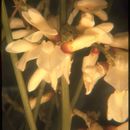en
names in breadcrumbs


Cytisus multiflorus is a species of legume known by the common names white broom,[3] white spanishbroom[4] and Portuguese broom.[5]
It is native to the Iberian Peninsula, especially frequent in the western half in central and northern interior Portugal[6] and central and northern western Spain.[7] It is better known as an introduced species on other continents, including Australia and North America, where it has become a weed in agricultural land and an invasive species in natural habitats.
Cytisus multiflorus is a shrub growing up to 0.8 metres (2 ft 7 in) or 1.5 metres (4 ft 11 in) in sprawling height,[7] with a broomlike array of many five-angled flexible branches. Leaves appear mainly on lower branches, each made up of three leaflets. Some leaves grow on the upper branches; these are generally made up of a single leaflet. Each leaflet is under a centimeter long and may be linear to oblong in shape and coated in soft silvery hairs.
The white, pea-like flower is up to a centimeter long and is often marked with a dark pinkish streak near the base. The fruit is a hairy legume pod up to 3 centimetres (1.2 in) long. The pods turn black with age and dehisce explosively to release their four to six seeds away from the parent plant.
This plant is a serious noxious weed of agricultural fields and a colonizing invasive plant in wild lands in parts of Australia and California,[8] where it was first introduced as an ornamental shrub for its prolific white flowers. It is still sometimes grown and sold for landscaping purposes despite its status as a pest plant, with new industry and public education programs resulting.[9][10]
Cytisus multiflorus is a species of legume known by the common names white broom, white spanishbroom and Portuguese broom.